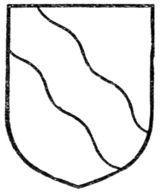When a bend and a bordure appear upon the same arms, the bend is not continued over the bordure, and similarly it does not surmount a tressure (Fig. 78), but stops within it.
A bend upon a bend is by no means unusual. An example of this will be found in a coat of Waller. Cases where this happens need to be carefully scrutinised to avoid error in blazoning.
A bend lozengy, or of lozenges (Fig. 79), will be found in the arms of Bolding.
A bend flory and counterflory will be found in the arms of Fellows, a quartering of Tweedy.
A bend chequy will be found in the arms of Menteith, and it should be noticed that the checks run the way of the bend.
Ermine spots upon a bend are represented the way of the bend.
Occasionally two bends will be found, as in the arms of Lever: Argent, two bends sable, the upper one engrailed (vide Lyon Register—escutcheon of pretence on the arms of Goldie-Scot of Craigmore, 1868); or as in the arms of James Ford, of Montrose, 1804: Gules, two bends vairé argent and sable, on a chief or, a greyhound courant sable between two towers gules. A different form appears in the arms of Zorke or Yorke (see Papworth), which are blazoned: Azure, a bend argent, impaling argent, a bend azure. A solitary instance of three bends (which, however, effectually proves that a bend cannot






